ESD storage containers protect your electronics best because they're engineered with specialized materials that safely dissipate static charges. You'll find these containers maintain a precise resistance level between 10^6 to 10^9 ohms/square, preventing harmful discharge while allowing controlled static flow. They're particularly effective in low humidity environments where static buildup can reach up to 90,000 volts. Your sensitive components stay safe thanks to multi-layer protection systems that combine conductive and non-conductive materials. The containers also shield against moisture, UV light, and physical damage. Understanding the science behind ESD protection reveals even more fascinating aspects of these essential storage solutions.
Understanding Static Electricity Fundamentals
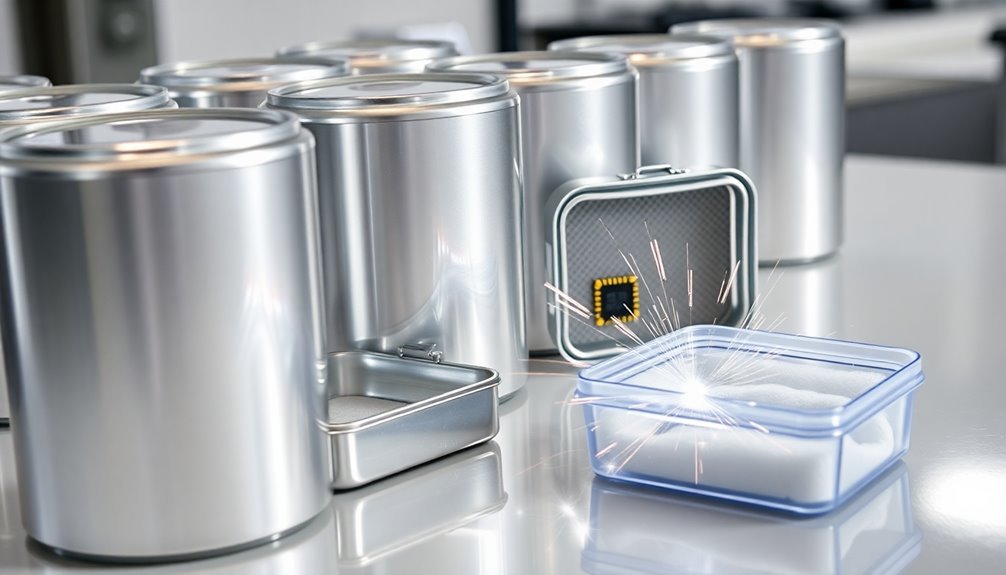
Static electricity poses a significant threat to electronic components, making it essential to understand its basic principles. When you handle electronic devices, you're dealing with an invisible force created by an imbalance of electrical charges on material surfaces. This imbalance occurs when electrons transfer between materials through contact, separation, or rubbing – a process known as the triboelectric effect. Air acts as insulator between surfaces, allowing charges to accumulate until discharge occurs.
You'll find that static electricity follows predictable behavior patterns. Like charges repel each other, while opposite charges attract. When charges build up on non-conductive surfaces, they can't easily dissipate, leading to potential discharge problems. These discharges, even in small amounts, can severely damage sensitive electronic components. Non-conductive materials can generate charges up to 90,000 volts during material flow or movement.
Several factors influence static charge generation, including the contact area between materials, separation speed, and environmental humidity. In low-humidity environments, you'll notice more static buildup because moisture helps conduct charges away.
When static electricity discharges, it can create voltages high enough to destroy microelectronic components instantly. That's why proper storage solutions that prevent charge accumulation are vital for protecting your electronic devices. Understanding these fundamentals helps you appreciate why ESD storage containers are specifically designed to manage static electricity risks.
ESD Damage Prevention Mechanisms
When you're protecting sensitive electronics from ESD damage, you'll find that effective static charge dissipation relies on specialized container materials with surface resistance between 10^6 and 10^9 ohms/square.
Your ESD storage containers work by safely channeling static charges through conductive or anti-static materials, preventing sudden discharges that could harm components. The containers' relative humidity requirement must be at least 15% for proper static dissipation performance. Made from durable polypropylene, these containers offer excellent resistance against oils, acids, and other potentially damaging substances.
Multi-layer protection systems in these containers combine conductive outer shells with anti-static inner layers and foam inserts, creating a thorough shield against both direct static contact and electromagnetic interference.
Static Charge Dissipation Methods
Electronic devices require robust protection against electrostatic discharge through multiple dissipation methods.
You'll find that grounding serves as a primary defense, particularly for conductive materials, by connecting all conductors to a common point that allows charges to flow and neutralize. When you're handling sensitive electronics, ESD wrist straps and grounding mats provide essential protection by creating safe pathways for static discharge. The human body can store charges up to 25,000 volts when unprotected. Triboelectric charging occurs naturally during routine handling and contact with surfaces.
You can enhance protection further by incorporating antistatic materials, which actively prevent static buildup through conductive pathways. These materials, including conductive polymers and carbon-based substances, work alongside static dissipative materials that offer controlled discharge with higher electrical resistance.
For extensive protection, you'll need to take into account ionization and humidity control methods. Ionization effectively neutralizes static fields on insulators by flooding the area with balanced positive and negative ions.
While humidity control isn't as effective as ionization, it still helps reduce static accumulation. When you're designing storage solutions, combining these methods creates a multi-layered defense system.
For instance, storage containers often integrate static dissipative materials with controlled discharge properties to safely protect sensitive electronic components.
Multi-Layer Protection Systems
Multi-layer protection systems form the backbone of modern ESD storage solutions, combining specialized materials to create extensive safeguards for sensitive components.
You'll find these systems typically constructed with conductive materials like aluminum paired with non-conductive plastic layers, including polyethylene and PET, creating a Faraday cage-like shield that effectively dissipates static charges.
When you're storing sensitive electronics like printed circuit boards or network cards, you'll benefit from the multiple protective features these systems offer. Static-dissipative materials used in clear PVC provide controlled static release for optimal protection.
They don't just guard against static – they also protect your components from moisture, UV light, and physical damage.
The construction includes a black conductive metal layer combined with dielectric plastic, ensuring thorough protection while maintaining cost-effectiveness. The amine-free polyethylene material promotes exceptional corrosion resistance for long-term storage.
You can choose from various configurations, from antistatic bags to rigid packaging boxes, depending on your specific needs.
These containers often incorporate foam inserts and trays to provide additional impact protection.
Whether you're working with small components or larger assemblies, you'll find solutions ranging from 3.6 mil to 8 mil in thickness, with options for both transparent and opaque materials that meet strict medical and industrial standards.
Material Science Behind Protection
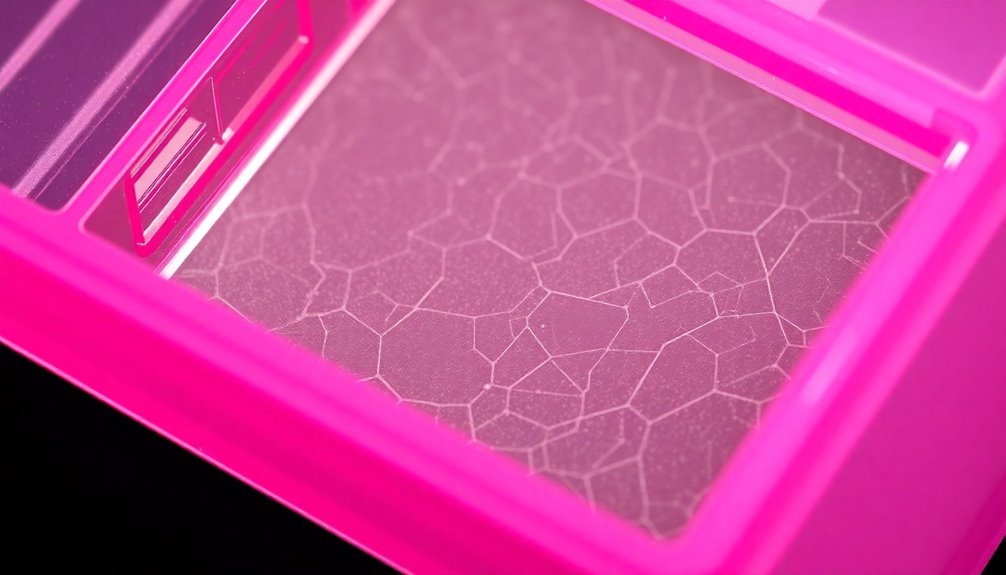
Understanding the science of ESD protection requires an in-depth exploration into specialized materials like high-density polyethylene (HDPE) and its variants. You'll find that these materials aren't just simple plastics – they're engineered specifically to manage static electricity through precise surface resistivity ranges and carefully controlled conductivity. Modern industry's reliance on electronics makes ESD protection more critical than ever before.
| Material Type | Resistivity (ohms/sq) | Key Feature |
|---|---|---|
| Conductive | 10^3 – 10^5 | Contains carbon black |
| Static Dissipative | 10^8 – 10^11 | Balanced protection |
| Anti-Static | 10^9 – 10^12 | Humidity dependent |
When you're selecting ESD storage containers, you'll need to take into account how carbon black particles in conductive materials provide permanent protection through their ability to dissipate static charges when grounded. However, you should note that these particles can slough off, making them unsuitable for clean room environments. The consistency of your chosen material is vital – that's why manufacturers like RTP Company focus on maintaining strict quality control over their raw materials. Surface resistivity levels between 10^6 to 10^9 ohm/sq ensure optimal protection for sensitive components. You'll want to verify your containers meet relevant standards like MIL-B-81705-B for electromagnetic shielding and REACH compliance, guaranteeing reliable protection for your sensitive electronic components.
Common ESD Container Types
Building on the material science fundamentals, let's explore the main types of ESD storage containers available in today's market.
You'll find four primary categories that serve different storage needs: component boxes, specialized containers, stackable totes, and storage bins.
Component boxes offer basic protection through anti-static properties while protecting against physical damage. You'll often see these with conductive foam inserts for fragile items.
For larger operations, Euro containers provide stackable solutions that maximize space efficiency while maintaining ESD protection.
When you need advanced protection, specialized containers like Corstat ESD protection systems and fibreboard boxes offer customizable solutions with features such as hardwood stacking runners and dividers.
These containers often include static shielding for extra protection against external discharges.
For production environments, you'll want to take into account stackable and nesting totes. They're particularly useful with their divider systems and durability.
The storage bins and boxes category rounds out your options, featuring polypropylene construction that resists chemicals and temperature extremes from -20° to +100° Celsius.
These containers work exceptionally well for PCB boards and electronic components in laboratory or cleanroom settings.
Static Dissipation Technology
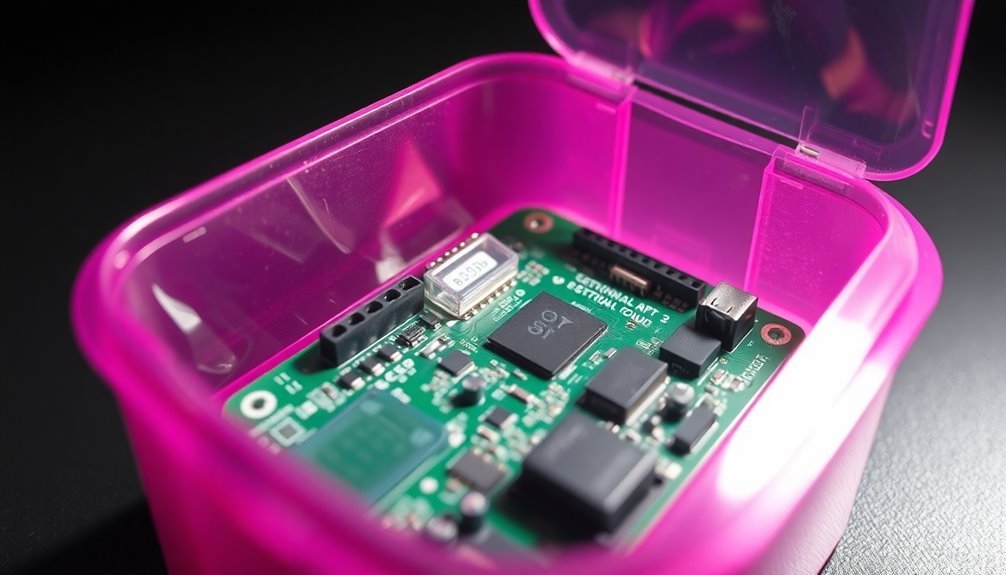
Static dissipation technology serves as the backbone of effective ESD protection in storage containers. When you're dealing with sensitive electronics, you'll find that these containers feature surface resistivity between 10^8 and 10^12 ohms per square inch, ensuring controlled dissipation of static electricity. The technology works by rapidly reducing static charges from 5kv to 50v in less than 2 seconds, protecting your components from potential damage.
You'll notice that manufacturers use specific materials like ABS, polypropylene, and specialty plastics that aren't fully conductive or insulative. This careful balance allows for controlled static dissipation while maintaining component safety.
These materials continue working constantly to maintain a static-safe environment, regardless of environmental conditions like moisture or temperature changes.
When you're selecting an ESD container, you'll need to take into account the material's compliance with standards like REACH and RoHS. The technology's versatility means you can find containers in various sizes and designs to fit your specific needs.
Remember that proper static dissipation technology maintains its protective properties long-term, making it a reliable solution for storing and handling electronic components.
Container Design Benefits
You'll find modern ESD storage containers equipped with compartmentalized sections that prevent component-to-component contact while maintaining consistent static protection throughout each divided space.
The containers' static-dissipative material construction actively works to prevent charge buildup and safely channel any existing static electricity to ground.
Strategic cushioning systems are integrated into the design, combining shock absorption with ESD protection to safeguard your sensitive electronic components during storage and transport.
Compartmentalized Protection Features
In addition to basic ESD protection, compartmentalized storage containers offer several design benefits that maximize both efficiency and component safety. You'll find customizable compartments that create tailored storage solutions for different electronic components, while practical dividers prevent damage from direct contact between parts.
These containers feature anti-static materials and enclosed designs that shield your components from external interference and static electricity. The foam trays provide essential cushioning against physical damage, while secure containment prevents movement that could harm sensitive electronics.
| Protection Feature | Benefit |
|---|---|
| Humidity Control | Prevents static buildup |
| Temperature Regulation | Reduces component damage |
| Proper Ventilation | Dissipates static charges |
| Clean Environment | Minimizes contamination |
| Grounding Systems | Guarantees ESD protection |
You'll notice improved inventory management with these compartmentalized containers, as they allow for easier tracking and quick retrieval of components. The visible storage design helps you identify parts instantly, reducing handling time and exposure to static sources. These features not only protect your electronics but also streamline assembly processes while maintaining compliance with industry standards.
Static-Dissipative Material Construction
Engineered with precision, static-dissipative materials offer critical protection through their unique electrical properties, featuring surface resistivity between 10^8 and 10^11 ohms per square. This specific range guarantees your electronics won't suffer from sudden discharges while allowing controlled dissipation of static buildup.
You'll find these materials particularly effective at preventing harmful charges from transferring during human contact. The static decay rate provides remarkable protection, reducing charges from 5kV to 50V in less than 0.50 seconds. You can rely on this rapid reduction to keep your electronic components safe during both handling and transport.
The material's environmental durability adds another layer of protection – it's resistant to air, moisture, and various chemicals, including weak acids and strong alkalis.
You'll appreciate the double-thick wall construction that meets stringent safety standards. These containers are made from recyclable polymer #5 and comply with California Prop 65 and EU regulations.
They're free from BPA, latex, and animal-derived materials, making them ideal for diverse industrial applications. When you're storing sensitive electronics, you can trust these containers to maintain their protective properties while meeting international safety requirements.
Cushioning System Integration
Building upon the protective material properties, modern ESD storage containers feature sophisticated cushioning systems that take component safety to the next level.
You'll find innovative designs that combine ESD foam, specialized trays, and customized compartments to provide maximum protection for your sensitive electronic components.
When you're handling delicate electronics, these integrated cushioning systems offer critical advantages that standard containers can't match:
- Your components stay firmly in place through specialized ESD foam and blister trays, preventing movement-related damage during transportation.
- You'll get consistent static protection through every layer of the container, from the outer shell to the innermost cushioning.
- Your storage efficiency improves with customizable compartments that match specific component shapes and sizes.
- You're able to maintain component integrity for extended periods, thanks to the combination of physical protection and static dissipation.
Whether you're storing microchips for aerospace applications or protecting automotive electronic modules, these cushioning systems work seamlessly with the container's ESD properties.
The result is a thorough protection solution that safeguards your components from both physical damage and static discharge throughout their storage and handling lifecycle.
Real World Protection Applications
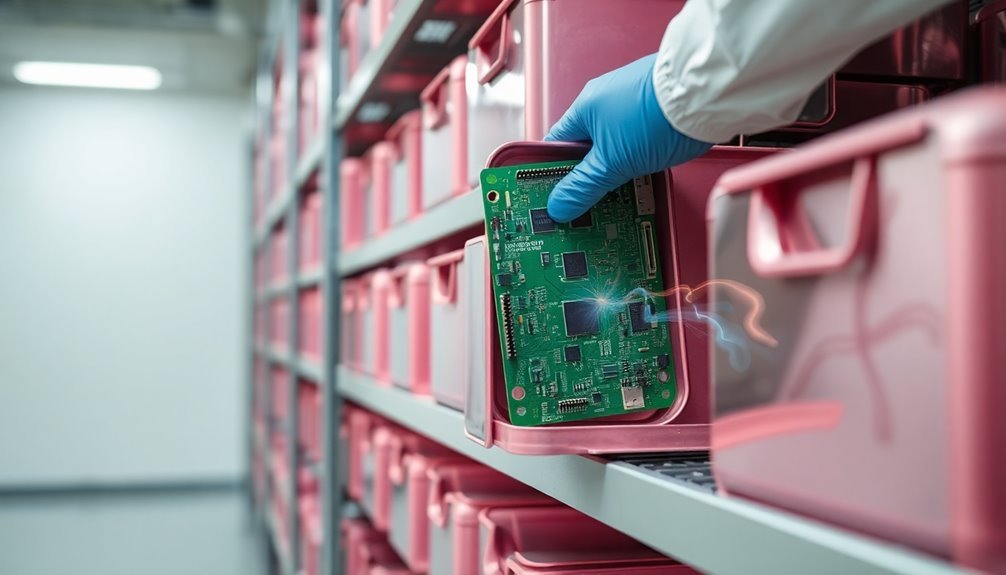
Throughout diverse industries, ESD storage containers serve as critical safeguards for protecting sensitive electronic components from electrostatic discharge damage. You'll find these containers extensively used in manufacturing and assembly lines, where they provide static protection during component handling and transport.
In cleanroom environments, they're particularly valuable as they don't release conductive particles that could compromise sensitive operations.
When you're shipping or storing electronic components, you'll benefit from the containers' stackable design and durable construction. They feature foam inserts and dividers that offer additional protection and organization, while their temperature resistance guarantees your components stay safe across various environmental conditions.
You'll notice industry-specific applications across medical, pyrotechnic, automotive, and electronics sectors. Manufacturers can provide you with customized solutions to meet your unique requirements, including specialized sizes and configurations.
The containers' materials are resistant to oils, acids, and alkalis, making them versatile for different applications. They're also compliant with important regulations like REACH and RoHS, assuring you're meeting safety and environmental standards while protecting your sensitive components.
Quality Standards For Storage
You'll need to guarantee your ESD storage containers meet stringent industry certifications like MIL-B-81705-B, which sets the baseline for electrostatic protective materials and electromagnetic shielding.
Your containers must undergo thorough testing protocols, including surface resistivity measurements between 10^3 to 10^9 ohms per square inch and static decay rate verification under 2 seconds.
When selecting ESD storage solutions, you should verify both mandatory compliance standards and optional certifications like REACH and RoHS, depending on your specific industry requirements.
Industry Certification Requirements
Quality control in ESD storage containers demands strict adherence to multiple industry standards and certifications.
You'll need to guarantee your storage solutions meet critical requirements like MIL-B-81705-B specifications for barrier materials and surface resistance standards of less than 10^5 ohms for conductive containers.
When selecting ESD storage containers, you must verify they meet these essential certification requirements:
- Static decay rate validation – containers must demonstrate ability to decay a 5000V charge in under 2 seconds
- Temperature resistance certification – materials must withstand -20°C to +100°C for safe storage
- Surface resistivity compliance – regular testing to maintain specified ohm levels per square inch
- Cleanroom compatibility verification – containers must meet particle contamination standards
You'll also need to guarantee your containers comply with REACH and RoHS standards for environmental safety.
If you're handling specialized components, consider custom ESD solutions with specific material requirements like conductive polypropylene or high-density polyethylene.
Your storage containers should integrate seamlessly with ESD Protected Areas (EPA) while providing consistent electrostatic shielding.
Regular testing and validation of these requirements isn't optional – it's vital for maintaining certification compliance and protecting your sensitive electronic components.
Material Testing Protocols
The thorough testing of ESD storage containers requires rigorous protocols to guarantee consistent protection of electronic components.
You'll find that surface resistance testing is a critical measure, verifying materials can effectively dissipate static electricity. For containers to be classified as conductive, they must demonstrate a surface resistance of 10^5 ohms per square inch or less.
When you're evaluating ESD storage containers, you'll need to validate their static decay rate, which should dissipate charges in less than 2 seconds. These tests follow military specifications like MIL-B-81705-B to guarantee reliable protection.
You'll want to confirm that your containers maintain their protective properties across various temperatures, typically from -20°C to +100°C.
Testing also includes durability checks for materials like HDPE and PP, which must withstand impacts while maintaining their ESD properties.
You'll need to take into account cleanroom compatibility, as some materials may release particles that could contaminate sensitive environments.
Surface resistivity measurements help you distinguish between conductive materials (10^5 ohms per square inch) and anti-static materials (10^12 ohms per square inch), verifying you choose the right protection level for your electronic components.
Cost Effectiveness Of ESD Containers
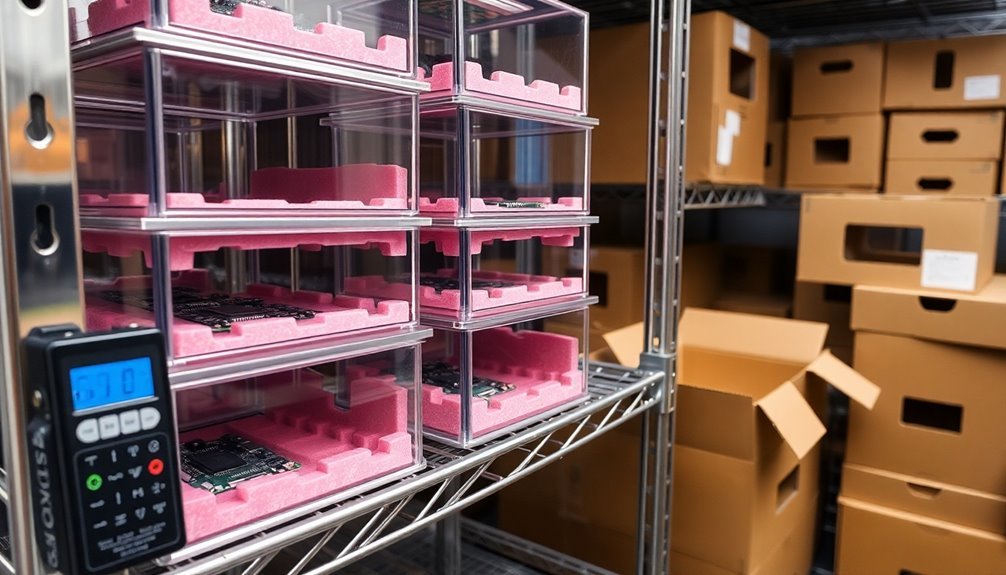
Investing in ESD storage containers offers substantial cost benefits that extend far beyond their initial purchase price. While you might initially hesitate at the higher upfront cost compared to non-ESD alternatives, the long-term savings and protection they provide make them a smart investment for your electronics manufacturing process.
Here's why ESD containers prove cost-effective:
- You'll greatly reduce rework costs by preventing static damage during storage and handling, which means fewer component failures and repairs.
- You're extending the lifespan of your electronic components through consistent protection against static charges, leading to better product reliability.
- You can avoid costly latent defects that might only surface after products reach customers, protecting your reputation and preventing warranty claims.
- You're getting durable, high-quality containers that comply with industry standards like MIL-B-81705, ensuring long-term reliability.
The investment in quality ESD storage solutions pays off through reduced damage rates, improved component longevity, and enhanced product integrity.
Future Of ESD Protection
Building on the cost-effectiveness of current ESD solutions, advances in material science and technology are reshaping the future of static protection.
You'll see groundbreaking developments in carbon nanotube and graphene-based materials that offer superior static dissipative properties while maintaining durability and reliability.
The future of ESD protection extends beyond traditional containers.
You'll find smart technologies integrated into storage systems that provide real-time monitoring of static charge levels.
New designs feature stackable bins with enhanced ventilation and specialized foam inserts, optimizing both space and protection for delicate electronic components.
To meet evolving industry demands, manufacturers are developing customizable ESD containers that comply with stringent standards like MIL-B-81705.
You'll benefit from improved ionization techniques and humidity control systems that effectively neutralize static charges in sensitive areas.
These advancements will be particularly vital as electronic components become increasingly sensitive to electrostatic discharge.
When you're working with advanced electronics, you'll appreciate the integration of ESD-safe workstations with built-in grounding systems and the development of homogeneous materials that provide consistent protection throughout your storage solutions.
These innovations guarantee your components remain safe as technology continues to advance.
Frequently Asked Questions
Can ESD Containers Protect Electronics During Natural Disasters Like Lightning Strikes?
No, your ESD containers won't protect electronics from lightning strikes or natural disasters. They're only designed to handle static electricity in controlled environments. You'll need additional protective measures for severe weather events.
What Happens if Food or Liquid Spills Inside an ESD Container?
If you spill food or liquid inside an ESD container, it'll compromise the container's protective capabilities. You'll need to clean and dry it immediately to prevent damage to electronics and restore proper surface resistance.
How Often Should ESD Containers Be Tested for Their Protective Properties?
You'll need to test your ESD containers annually for compliance, perform biannual visual inspections, and conduct monthly cleaning checks. Don't skip quarterly environmental control assessments to maintain ideal protective properties.
Do ESD Containers Expire or Lose Effectiveness Over Time?
Yes, your ESD containers can lose effectiveness over time due to material degradation, wear, and environmental factors. You'll need to regularly test them and replace containers that don't meet protective standards anymore.
Can Modified ESD Containers Provide Better Protection Than Standard Factory Designs?
Yes, you'll get superior protection with modified ESD containers since they feature enhanced materials, customized designs, and specialized coatings. Their improved carbon content and surface resistance offer better static dissipation than standard containers.
In Summary
ESD storage containers protect your electronics because they're engineered with specialized materials that prevent static buildup and safely dissipate charges. You'll find they create a Faraday cage effect, shielding sensitive components from electrical damage. When you're storing or transporting electronic parts, these containers provide the most reliable protection through their conductive or static-dissipative properties, meeting industry standards while remaining cost-effective for both short and long-term storage.

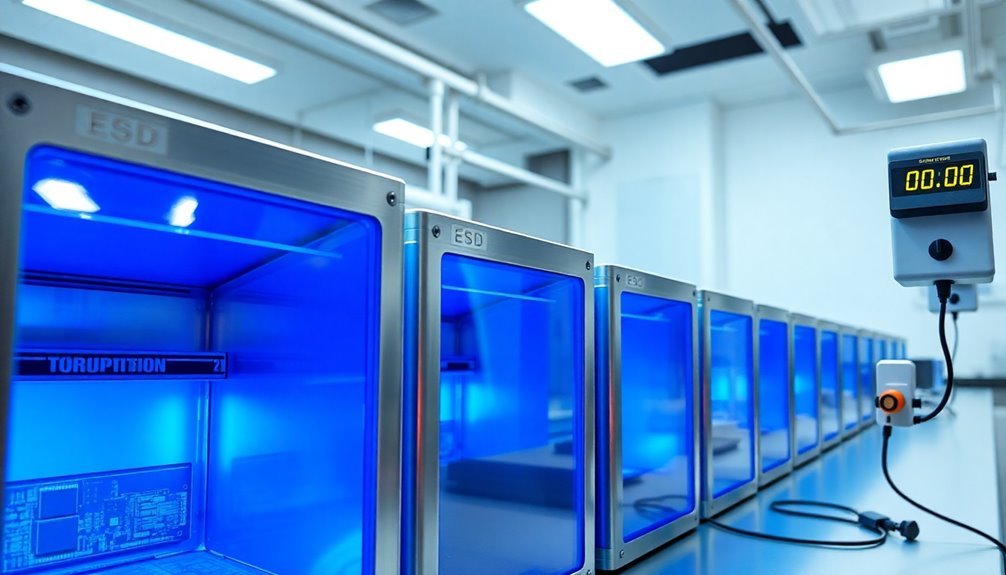



Leave a Reply